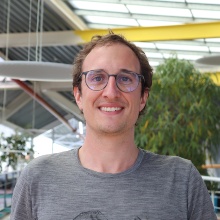Yann Rivas, SFB 1313 doctoral researcher at the Institute of Applied Mechanics (CE) (research project B02), will give his milestone presentation on "Fluid flow in fractured and fracturing porous materials based on the Theory of Porous Media" on 27 March 2025.
Date: Thursday, 27 March 2025
Time: 10 am CET
Venue: Pfaffenwaldring 9, Seminar Room MIB, Room: 3.141
Title: "Fluid flow in fractured and fracturing porous materials based on the Theory of Porous Media"
Venue: Pfaffenwaldring 9, Seminar Room MIB, Room: 3.141. If you are interested to participate online in Yann Rivas' milestone presentation, please contact Samaneh Vahid Dastjerdi to receice the Webex link >>> samaneh.vahiddastjerdi@mechbau.uni-stuttgart.de
Abstract
Understanding coupled processes in fractured and fracturing porous materials is of crucial importance for many engineering and environmental applications. In the SFB1313 research project B02, we proceed from the Theory of Porous Media (TPM) providing a first-principles-based modelling framework. One fundamental aspect of the TPM is that the solid body and therefore its mechanical behaviour due to external forces is acting as a reference frame for the contained constituents, e. g. liquids, gases or mixtures of both. In recent works at our institute this important solid-fluid coupling was exploited to describe dynamic (hydraulic) fracture propagation in porous materials using a phase-field approach. Therein, a phase-field variable is coupled to the solid displacements and indicates whether the material is intact or fractured. The diffuse transition between those distinct regions is regulated by a simple length-scale parameter ϵ.
Evolving around these works, my work focuses on the general flow behaviour in fractured porous materials with a special regard on the transition between free flow and porous media flow. A diffuse transition is intrinsically given by the phase-field approach. To study meaningful values of the length-scale parameter ϵ, we set up a combined numerical-experimental investigation with the Porous Media Lab (PML) at the University of Stuttgart. This led to a theoretical choice of ϵ based on the roughness of the interface, verified by microfluidic experiments through a comparison of the simulated and experimental velocity fields.
In this talk, I will present the basic theoretical framework around the biphasic TPM phasefield model and its application to microfluidic experiments as well as an introduction to these experiments and their evaluation. Furthermore, I will discuss the model extension towards the description of mass-exchange processes between the fractured solid and the mobile pore liquid.Thereby, the local volume fraction of the solid changes since crushed solid particles are transferred to the fluid-solid mixture, dependent on the flow velocities. The arising change in the viscosity is considered here and discussed for two different viscosity models.
Transferring from flow related phenomena to natural hydraulic fracturing I will talk about a model which contains a liquid-gas mixture instead of a single pore liquid to consider larger global deformations due to the compressibility of the gas. This is a necessary improvement to model experiments where a complete degassing of the pore fluid is not guaranteed.
Finally, I will present an overview of further current SFB1313-related collaborations with the project areas A02, AX5 and Z02 concerning flow through microfluidic devices and improved experimental setups as well as project area A03 where we develop ideas to improve numericalsolution schemes.


